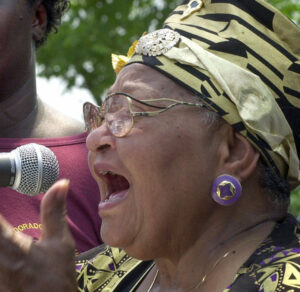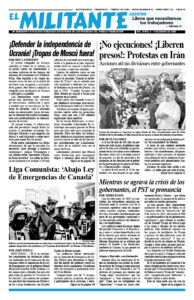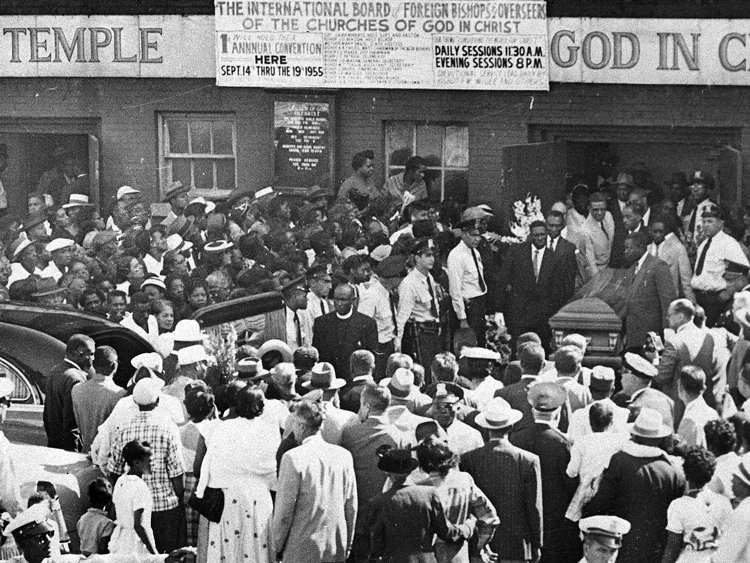“Till,” 2022, a film directed by Chinonye Chukwu, written by Michael Reilly, Keith Beauchamp, and Chinonye Chukwu, starring Danielle Deadwyler.
If you want to learn about the powerful movement that ended the brutal Jim Crow system of segregation in the South, this movie misses the mark. It focuses on Mamie Till, whose 14-year-old son Emmett was cold bloodedly lynched while visiting relatives in Mississippi in 1955. But it shows very little of how Mamie Till decided to step up and lead years of protests against the acquittal of the two racists who lynched her son, and how it helped build the civil rights movement.

If you want to learn more about this, check out the articles written at the time in the Militant. Go to www.themilitant.com beginning in August 1955 and you can follow the wave of protest meetings organized by Mamie Till, the NAACP and the trade union movement for the next two years.
And there is a good film on this important piece of history, the 2003 PBS documentary, “The Murder of Emmett Till,” directed by Stanley Nelson.
The world changed because of the mighty struggle that tore down Jim Crow in the South and spread to the North. But “Till” ends by implying that nothing has changed. The fact is these proletarian-led struggles transformed the thinking of working people forever. And the fight around Emmett Till’s murder played an important part. If you want to join in this debate, then you should see this movie.
The fight to overturn Jim Crow
Jim Crow was set up in the South after the bloody defeat of the Radical Reconstruction governments that came out of the Second American Revolution — the Civil War that overturned slavery. That was the biggest setback for the U.S. working class in our entire history. The rural poor and working class were forcibly divided along color lines by Klan violence. Class solidarity was crippled and racist oppression enshrined. It was enforced by state power, in the southern states and in Washington, D.C., by both Democrats and Republicans.
From 1880 to 1960, thousands of Black men and women were lynched, tortured and mutilated, including sharecroppers, farmers, store owners, miners, railroaders and other toilers. There is no way to know the exact number. People would just disappear.
The lynch mobs were still active in the 1950s, but now protests answered the lynchings. And the civil rights mobilizations grew, spreading to every city and town. Jim Crow’s days were numbered. The response to the killing of Emmett Till, the 1955-56 Montgomery Bus Boycott, 1960 Woolworth lunch counter sit-ins, 1961 Freedom Rides, 1963 Battle of Birmingham, 1965 Selma-to-Montgomery march, the organization of self-defense efforts in Louisiana, Mississippi, North Carolina and more, became overwhelming.
These battles won support and awakened struggles for equal rights across the country. African Americans who led these struggles saw them as a part of the fight for national liberation sweeping Africa, Asia and elsewhere. In the words of Malcolm X, millions were awakening to their self-worth.
The lynching of Emmett Till
On Aug. 24, 1955, after working in the fields, Emmett and some other youth went to a store for snacks in the small rural town of Money, Mississippi. He bought some candy from Carolyn Bryant, who owned the store along with her husband Roy Bryant. The story that was spread was that Till cat-whistled at her inside the store. In the Jim Crow South that was unacceptable.
Three days later, Emmett Till was kidnapped from his uncle’s house. Two racists pistol-whipped him, shot him in the head, tied a 75-pound fan around his neck with barbed wire, and threw his body into the Tallahatchie River.
The lynching of Emmett Till was part of a wave of racist terror that swept the South in response to the 1954 Brown v. Board of Education decision by the U.S. Supreme Court that outlawed public school segregation.
The jury took just an hour to acquit Roy Bryant and his brother-in-law, J.W. Milam. Mamie Till led opponents of Jim Crow who had come down to witness the trial away from the courthouse before the jury came back, knowing there would be a victory rally for the killers. “It was like the Fourth of July,” she said.
The coffin containing Emmett Till’s body came to Chicago nailed shut, his mother was instructed not to open it. She told the funeral home that if they didn’t open it, she would get a hammer and do it herself. “Let the people see what I’ve seen,” she said.
The funeral of Emmett Till had a big impact on me, even though I was only 6 at the time. I grew up on the South Side of Chicago, about a mile from where Emmett Till lived with his mother. The funeral was in my neighborhood.
Those were turbulent times. I remember desegregation battles that took place over housing in Chicago. More than once, my friends and I were chased off Lake Michigan beaches by white gangs of youth who wanted to keep them “for whites only.”
Emmett Till’s funeral was a turning point for the civil rights movement there. According to the Chicago Defender, 250,000 people filed by the church on 40th and State Street, where the casket lay open for four days for all to see what the racists had done. My mother took me. She had become part of the fight for desegregation in Chicago. The line wound through the neighborhood for blocks on end. I remember seeing people who had obviously traveled a long way for the event, including Black men wearing African robes, Black youth, Black families, union members.
We stood in line for hours in protest of the lynching. My mother didn’t take me into the funeral home. Later, I saw the photos showing the mutilized face of Emmett Till in Jet magazine, which was passed from hand to hand in the schools, in Black churches, at workplaces, and on the streets, reaching millions of people. My friends in Sunday school showed me the tattered magazine.
For months afterward, protests of thousands sponsored by the NAACP and various unions took place from coast to coast. Some of these are described in a book called The Blood of Emmett Till by Timothy Tyson. “Jammed into the Garment District on 36th Street between Seventh and Eighth” in New York, he writes, “the twenty-thousand protesters roared their approval when [Congressman] Adam Clayton Powell Jr. proposed a national boycott on Mississippi products and a March on Washington in January to demand that Congress finally pass an anti-lynching bill.”
There were scores of similar actions. The United Steelworkers, United Auto Workers, longshore workers, the Brotherhood of Sleeping Car Porters, District 65 of the Retail, Wholesale and Department Store Workers Union, the Jewish Labor Committee and others joined with the NAACP to hold giant protests.
Week after week, the Socialist Workers Party championed the struggles of the civil rights movement and the fight against Jim Crow in the Militant. The new film only briefly shows one of these rallies, which was in Harlem.
The NAACP pulls back
While the NAACP had spearheaded the protests against the Emmett Till lynching, they began to step back from demonstrations in 1956. It was an election year, and the NAACP was backing Democrat Adlai Stevenson running against Republican Dwight D. Eisenhower. NAACP leaders saw reliance on the Democrats and the capitalist government as the way to secure civil rights.
Despite having raised hundreds of thousands of dollars at the rallies that Mamie Till spoke at, the NAACP pulled back financial support for her. She had given up her job to tour the country full time for the organization.
The NAACP and labor unions backed off from the call for a national march on Washington against lynchings. But others stepped forward. The Montgomery Bus Boycott was organized in response to Rosa Parks’ Dec. 1, 1955, decision not to give up her seat and move to the back of the bus. Mobilizing tens of thousands of Black workers in Montgomery, Alabama, winning support from the civil rights movement in the South, as well as unions in the North, this fight was victorious one year later.
Powerful working-class movement
This massive historic social struggle swept not only the South but across the U.S. for well over a decade. It built on the battles that forged the industrial unions in the 1930s, struggles by sharecroppers and tenant farmers, and in struggles during World War II against racism in wartime industries and lynch-mob terror and cop violence — as well as legal segregation of units inside the U.S. armed forces itself.
Jim Crow was defeated by the massive force of Black-led working-class power. The working class and our unions were immeasurably strengthened.
Mamie Till returned to Chicago, went to school and became an elementary school teacher. While she worked full time, and even after when she began to suffer from kidney failure, she freely gave the rest of her waking hours to the cause, speaking around the country, right until the end. She died in 2003.
I recommend the following book on the history of Radical Reconstruction, the victorious fight against Jim Crow, and the fight against racism today: Malcolm X, Black Liberation, and the Road to Workers Power by Socialist Workers Party National Secretary Jack Barnes.


